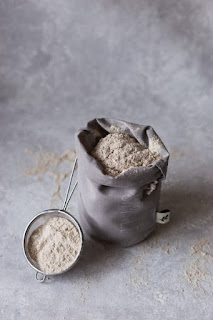Rice flour can be made from white or whole grain rice and is sold in the instant form made by a special process. It is mainly used to prepare sweet, unbaked desserts and is added to gluten-free bread mixes along with buckwheat, corn, and other gluten-free flours. The rice flour dough is firm, and quite similar to wheat flour dough, though not as flexible.
Rice flour is an excellent ingredient for baking gluten-free biscuits, cakes, and unleavened buns. Or suitable for thickening sauces of savory or sweet dishes. Rice flour increases the volume and binding of (gluten-free) mixtures. It does not contain gliadin (gluten fraction) and has a low sodium content. It is an easily digestible food that causes a feeling of satiety. It does not contain gluten and is therefore suitable for patients with celiac disease and for a gluten-free diet. Rice flour dough can be rolled out into a thin slice and rolled out of noodles, they will not disintegrate in water.
Rice generally contains about 7% protein and also has no gliadin. This makes it tolerable for patients with celiac disease. It is advisable to combine rice with legumes, such as lentils, because it contains little lysine and tryptophan. This will give us a very delicious meal and will supplement the necessary proteins for our body. If we add soy drink, we will add the necessary amino acids. We do not find fats in white rice, because they are mainly in the germ and bran. Whole grain rice has less than 3% of it, which is less than in oats, but they are much more biologically valuable. As for carbohydrates in rice - starches predominate, which is three-quarters of the grain.
In rice, ie mainly in whole grains, we find relatively well-represented B vitamins, mainly niacin, then B1,2,6, and folic acid. Rice is a rich source of phosphorus and potassium, less magnesium, even less calcium and zinc, and the least iron. All this if we supplement with vegetables, for example in the form of risotto, we get a good lunch or a light dinner.
Gastroenteritis - White rice is not very nutritionally rich, but it is a great helper in diarrhea and tuning of the intestinal mucosa for colitis or gastroenteritis. In children, it is possible to help with rice broth in the rapid loss of fluids during diarrhea. You can drip a few drops of lemon into it and it can be drunk as a single drink. There is plenty of potassium salts and complex carbohydrates in rice broth to alleviate or stop diarrhea.
High blood pressure - For people with high blood pressure, whole grain rice, and even white rice are suitable food for their low sodium content. It is important to drain the body well in people with hypertension. This is not possible with normal eating habits with the use of salt. Sodium retains fluids in the body, causing swelling and excessive stress on the heart.
High cholesterol - What we have said about hypertension and its treatment of rice, we can also say about high cholesterol LDL. There is no cholesterol in rice, but it has a good proportion of fiber, which slows down the absorption of bile acids in the intestine, which the liver uses to make cholesterol. Therefore, rice is a very suitable food for people who suffer from diseases of the heart and circulatory system.
Gout + Arthritis - And finally we will focus on gout and gouty arthritis. These diseases, due to the presence of foods high in uric acid - purines, afflict an increasing percentage of the population, especially in developed countries. It is interesting to compare the content of uric acid in food. Purines are part of our body, but if the diet is too rich in uric acid, it will not take long and we will feel gout as a result of the composition of our diet. In particular, the disease manifests itself in the toes as red and sensitive to touch. Surely you remember some high-ranking people, just during that Emperor Rudolf II suffered, among other diseases. There were usually many "delicacies" on the tables of these people, especially venison, red meat, cold cuts, chocolate, and a wide range of "abundances" that caused these attacks of gout for high levels of uric acid.
Acidification of the organism - Rice does not contain many proteins and has an alkaline effect. Therefore, it is a food that helps reduce acidification of the body.
Thank God for enlightenment and a return to really valuable and healthy food, which satisfies when it is nicely served, pleases the eye and heals where it passes.
Thanks for reading this blog please share or like and comments.




No comments:
Post a Comment